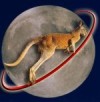In August 2003, the Earth passed by Mars, as it does every two years. But this time happened to be one of the closest approaches for thousands of years, and one of the few in recent times to occur during the summer on Mars's southern hemisphere.
During August and September, I joined many other amateur astronomers by training my telescope on Mars and taking many photographs. The most successful method for small telescopes involves using a video camera to take hundreds of individual frames, and then employing computer "stacking" software to stack the individual frames together and process them into a single image. By using this method, much of the noise and atmospheric effects which can be seen in individual frames are cancelled out leaving a much cleaner image. The programs I used were
Registax and Astrostack.
For a camera, I used my Fujifilm Finepix S602 digital camera. This is primarily a still image camera, but it has a VGA quality video capability of 30 frames per second. The camera was hand-held against the 9mm eyepiece of my Meade 10inch LX200 telescope to make each video. This method obviously added some blur due to unsteady hands, and it would have been better if the camera could have been rigidly fixed to the telescope. However, with 30fps and over 10 seconds for each video, it was still possible to select several hundred reasonable quality frames for stacking and processing to make each image.
As the Earth passed by Mars over several weeks, and as Mars rotated each day, it was possible to obtain images of different parts of Mars. I used the
Mars Previewer II
program to determine the Central Meridian (CM), or longitude, on Mars corresponding to each image.
The picture above shows the best of the images produced in this way. Click on the picture above to download a larger version. (800x600, 110kb)
|

